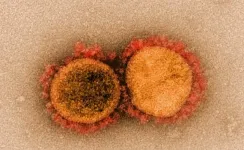(Press-News.org) Cells don't express all the genes they contain all the time. The portion of our genome that encodes eye color, for example, doesn't need to be turned on in liver cells. In plants, genes encoding the structure of a flower can be turned off in cells that will form a leaf.
These unneeded genes are kept from becoming active by being stowed in dense chromatin, a tightly packed bundle of genetic material laced with proteins.
In a new study in the journal Nature Communications, biologists from the University of Pennsylvania identify a protein that enables plant cells to reach these otherwise inaccessible genes in order to switch between different identities. Called a "pioneer transcription factor," the LEAFY protein gets a foothold in particular portions of the chromatin bundle, loosening the structure and recruiting other proteins that eventually allow genes to first be transcribed into RNA and then translated into proteins.
"The programs that are not needed in a given cell or tissue or condition are effectively shut off by various chromatin modifications that make them very inaccessible," says biologist Doris Wagner of the School of Arts & Sciences, senior author on the work. "The question has always been, How do you go from shut to open? We found that LEAFY, this protein that we already knew was important in reprogramming plant cells, is one of these pioneer transcription factors that get a foot in the door, as it were, to alter the program of cells."
Pioneer transcription factors were first characterized by Penn faculty member Kenneth Zaret of the Perelman School of Medicine, whose own work has examined these regulatory proteins in animals, such as in the context of liver development. Early in her time at Penn, Wagner heard Zaret give a talk about his work in this area and grew curious about looking for similar factors in plants, given that flexible gene expression is so critical to their survival.
Indeed, plants must switch between expressing whole sets of different genes all the time. In rich soils, they may grow more branches to get bigger, while in a drought they may express more genes associated with developing flowers, so they can set seed and reproduce before they succumb.
How plant cells determine their identity and fate has been a focus of Wagner's work since the start of her career, and so has LEAFY. During her postdoc days, Wagner showed that LEAFY could reprogram root cells to produce flowers. "That gave us a good clue that LEAFY might have this 'pioneer' activity, but we had to look more closely to prove it," she says.
To do so, Wagner and colleagues first used isolated protein and strands of genetic material to show that LEAFY, though not other transcription factors, bound to nucleosomes, subunits of chromatin where DNA spools on a cluster of proteins called histones. Specifically, the binding occurred at the gene AP1, which is known to be activated by LEAFY to prompt plants to make flowers.
To confirm that this connection was true in a living organism, the researchers took plant roots and applied a compound that causes them to flower spontaneously. When flowering, they found that not only did LEAFY bind strongly to AP1 but that the binding site was also occupied by a histone. "This tells us that the histones and LEAFY are really occupying the same portion of DNA," Wagner says.
Furthermore, they showed that chromatin structure began to open up at the AP1 region when LEAFY was activated, a key facet of what pioneer transcription factors do. This opening was limited, and full loosening of chromatin took days. What did happen quickly, the researchers found, was that LEAFY displaced a linker histone protein, creating a small local opening that also allowed other transcription factors to nose their way into the DNA.
Though pioneer transcription factors had been proposed to exist in plants, the new work provides the first concrete support backing this conception for LEAFY. And Wagner believes there are others. "If necessary, plants can alter their entire body plan or generate an entire plant from a little piece of leaf," she says. "We predict setting this in motion will require pioneer transcription factors. So plants may actually have more of these factors than animals."
In upcoming work, she and her team hope to delve more deeply into the processes that precede and follow this "pioneering" activity of LEAFY: Does anything restrict its activity and how do the other factors that it recruits fully unpack the hidden-away genes? "It would be great to find out both sides of this equation," Wagner says.
The findings have significance in agriculture and breeding, where LEAFY is already manipulated to encourage earlier flowering, for example. And as more is understood about pioneer transcription factors in plants, Wagner can envision a fine tuning of other aspects of plant growth and activity, which could be leveraged to help crops adapt to new environmental conditions, such as those being ushered in by climate change.
INFORMATION:
Doris Wagner is the Robert I. Williams Term Professor of Biology in the University of Pennsylvania School of Arts & Sciences.
Wagner's coauthors are gradute students Run Jin and Samantha Klasfeld, postdocs Yang Zhu and Jun Xiao, former graduate student Soon-Ki Han, undergraduate Adam Konkol of Penn's School of Arts & Sciences, and former Zaret lab graduate student Meilin Fernandez Garcia of Penn's Perlman School of Medicine.
This research was funded by the National Science Foundation Division of Integrated Organismal Systems (grants 1557529 and 1905062).
Irvine, Calif., Jan. 27, 2021 -- One of President Joe Biden's first post-inauguration acts was to realign the United States with the Paris climate accord, but a new study led by researchers at the University of California, Irvine demonstrates that rising emissions from human land-use will jeopardize the agreement's goals without substantial changes in agricultural practices.
In a paper published today in Nature, the team presented the most thorough inventory yet of land-use contributions to carbon dioxide and other greenhouse gases (including nitrous oxide and methane) from 1961 to 2017, taking into account emissions from agricultural production activities and modifications to the natural landscape.
"We estimated and attributed global land-use emissions among 229 countries ...
Gardeners and farmers around the country recognize that crop varieties grow best in certain regions. Most plant species have adapted to their local environments; for example, crop and ornamental seeds sold for the upper Midwest are often very different than those bred for Texas. Identifying and breeding varieties that have high productivity across a range of environments is becoming increasingly important for food, fuel and other applications, and breeders aren't interested in waiting decades to develop new crops.
One example is an ongoing collaborative effort to improve the emerging bioenergy crop ...
The development of cost-efficient, portable microscopy units would greatly expand their use in remote field locations and in places with fewer resources, potentially leading to easier on-site analysis of contaminants such as E. coli in water sources as well as other practical applications.
Current microscopy systems, like those used to image micro-organisms, are expensive because they are optimized for maximum resolution and minimal deformation of the images the systems produce. But some situations do not require such optimization--for instance, simply detecting the presence of pathogens in water. One potential approach to developing a low-cost portable microscopy system is to use transparent microspheres in combination with affordable ...
In September, a team led by astronomers in the United Kingdom announced that they had detected the chemical phosphine in the thick clouds of Venus. The team's reported detection, based on observations by two Earth-based radio telescopes, surprised many Venus experts. Earth's atmosphere contains small amounts of phosphine, which may be produced by life. Phosphine on Venus generated buzz that the planet, often succinctly touted as a "hellscape," could somehow harbor life within its acidic clouds.
Since that initial claim, other science teams have cast doubt on the reliability of the phosphine ...
Car accidents are responsible for approximately a million deaths each year globally. Among the many causes, driving at night, when vision is most limited, leads to accidents with higher mortality rates than accidents during the day. Therefore, improving visibility during night driving is critical for reducing the number of fatal car accidents.
An adaptive driving beam (ADB) can help to some extent. This advanced drive-assist technology for vehicle headlights can automatically adjust the driver's visibility based on the car speed and traffic environment. ADB systems that ...
A combination of observational data and sophisticated computer simulations have yielded advances in a field of astrophysics that has languished for half a century. The Dark Energy Survey, which is hosted by the U.S. Department of Energy's Fermi National Accelerator Laboratory, has published a burst of new results on what's called intracluster light, or ICL, a faint type of light found inside galaxy clusters.
The first burst of new, precision ICL measurements appeared in a paper published in The Astrophysical Journal in April 2019. Another appeared more recently in Monthly Notices of the Royal Astronomical Society. In a surprise finding of the latter, DES physicists discovered new evidence that ICL might provide a new way to measure a mysterious substance called ...
As surgeons balance the need to control their patients' post-surgery pain with the risk that a routine operation could become the gateway to long-term opioid use or addiction, a new study shows the power of an approach that takes a middle way.
In a new letter in JAMA Surgery, a team from Michigan Medicine at the University of Michigan reports on findings from a study of 620 patients who had surgery in hospitals across Michigan, had their painkiller use tracked, and took surveys within one to three months after their operations.
Half of the patients received pre-surgery counseling that emphasized non-opioid pain treatment as their first option. Some patients in this group received small, "just in case" prescriptions, but a third of them didn't receive any opioid prescription ...
LA JOLLA--A new study led by scientists at La Jolla Institute for Immunology (LJI) suggests that T cells try to fight SARS-CoV-2 by targeting a broad range of sites on the virus--beyond the key sites on the virus's spike protein. By attacking the virus from many angles, the body has the tools to potentially recognize different SARS-CoV-2 variants.
The new research, published January 27, 2021 in Cell Report Medicine, is the most detailed analysis so far of which proteins on SARS-CoV-2 stimulate the strongest responses from the immune system's "helper" CD4+ T cells and "killer" CD8+ T cells.
"We ...
INDIANAPOLIS--Researchers at the Indiana University Melvin and Bren Simon Comprehensive Cancer Center have identified how breast cancer cells hide from immune cells to stay alive. The discovery could lead to better immunotherapy treatment for patients.
Xinna Zhang, PhD, and colleagues found that when breast cancer cells have an increased level of a protein called MAL2 on the cell surface, the cancer cells can evade immune attacks and continue to grow. The findings are published this month in The Journal of Clinical Investigation and featured on the journal's cover.
The lead author of the study, Zhang is a member of the ...
Members of Syracuse University's College of Arts and Sciences are shining new light on an enduring mystery--one that is millions of years in the making.
A team of paleontologists led by Professor Cathryn Newton has increased scientists' understanding of whether Devonian marine faunas, whose fossils are lodged in a unit of bedrock in Central New York known as the Hamilton Group, were stable for millions of years before succumbing to waves of extinctions.
Drawing on 15 years of quantitative analysis with fellow professor Jim Brower (who died in 2018), Newton has continued to probe the structure of these ancient fossil communities, among the most renowned on Earth.
The group's findings, reported by the Geological Society of America (GSA), provide critical ...







